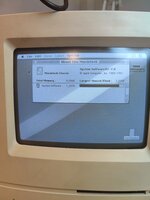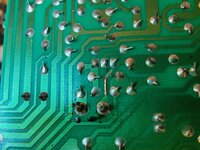Wow, I just realised how long it's been since I last posted about my Classic on here!! What with covid and moving house this year, I've not had much time to look at this.
However, it now lives again!!

So the logic board was dead, and I have been able to secure a replacement, which is great. At some point it had no display which wasn't helping and I found a damaged track on the analog board, near the middle on this image:

Once repaired I started to get a picture again, and in fact the CRT image is very nice once it's running.
However, we're not out of the woods yet.
The machine still has a power problem. If I switch it on, I either get a blank screen or unhappy Mac. I then leave it powered on and after about 5 minutes it bongs and there is a sound like a 'flup'. The dead Mac scrolls describes this sound, and now I understand what it is!!
It then continues to bong/flup for a minute or two before finally booting, so I think the PSU is failing to start and eventually does so once it warms up.
In terms of what I have already replaced so far this is it:
CP8 & CP12 in the 12V output circuit
CP6, CP7 & CP36 in the 5V circuit
In addition I have replaced CP2, CP9 & CP10 as they're in the same general area, and as it happens every last one of these were identified as leaking with brown goo at the bottom of each one.
I'm going to change the Schottky rectifier diode at DP6 which feeds the 5v supply (The 5v supply seems unstable when measured, plus these components are pretty cheap), and am intending to replace CP3 (This 'might' be the starter cap, I am not 100% sure due to lack of PSU knowledge) and CP11 and CP37 as they seem to be part of that circuit too.
If it's still doing this after replacing the components then I guess it could be another logic board problem, though everything I've found thus far does say logic board, and there are 2 ICs that could be playing up. One step at a time.
Overall I'm getting there, and hopefully pretty soon this little gem will be back to full working order



